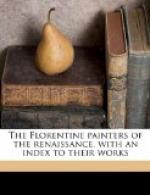converging lines. In his zeal he forgot local
colour—he loved to paint his horses green
or pink—forgot action, forgot composition,
and, it need scarcely be added, significance.
Thus in his battle-pieces, instead of adequate action
of any sort, we get the feeling of witnessing a show
of stuffed figures whose mechanical movements have
been suddenly arrested by some clog in their wires;
in his fresco of the “Deluge,” he has so
covered his space with demonstrations of his cleverness
in perspective and foreshortening that, far from bringing
home to us the terrors of a cataclysm, he at the utmost
suggests the bursting of a mill-dam; and in the neighbouring
fresco of the “Sacrifice of Noah,” just
as some capitally constructed figures are about to
enable us to realise the scene, all possibility of
artistic pleasure is destroyed by our seeing an object
in the air which, after some difficulty, we decipher
as a human being plunging downward from the clouds.
Instead of making this figure, which, by the way, is
meant to represent God the Father, plunge toward us,
Uccello deliberately preferred to make it dash inward,
away from us, thereby displaying his great skill in
both perspective and foreshortening, but at the same
time writing himself down as the founder of two families
of painters which have flourished ever since, the
artists for dexterity’s sake—mental
or manual, it scarcely matters—and the naturalists.
As these two clans increased rapidly in Florence,
and, for both good and evil, greatly affected the
whole subsequent course of Florentine painting, we
must, before going farther, briefly define to ourselves
dexterity and naturalism, and their relation to art.
[Page heading: ART FOR DEXTERITY’S SAKE]
The essential in painting, especially in figure-painting,
is, we agreed, the rendering of the tactile values
of the forms represented, because by this means, and
this alone, can the art make us realise forms better
than we do in life. The great painter, then, is,
above all, an artist with a great sense of tactile
values and great skill in rendering them. Now
this sense, though it will increase as the man is revealed
to himself, is something which the great painter possesses
at the start, so that he is scarcely, if at all, aware
of possessing it. His conscious effort is given
to the means of rendering. It is of means of rendering,
therefore, that he talks to others; and, because his
triumphs here are hard-earned and conscious, it is
on his skill in rendering that he prides himself.
The greater the painter, the less likely he is to be
aware of aught else in his art than problems of rendering—but
all the while he is communicating what the force of
his genius makes him feel without his striving for
it, almost without his being aware of it, the material
and spiritual significance of forms. However—his
intimates hear him talk of nothing but skill; he seems
to think of nothing but skill; and naturally they,
and the entire public, conclude that his skill is




